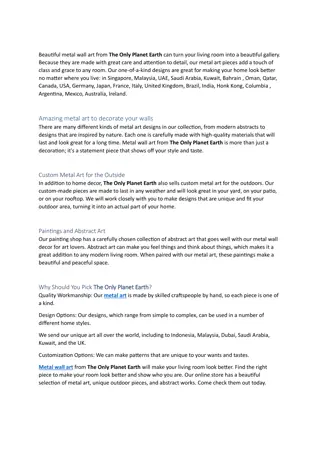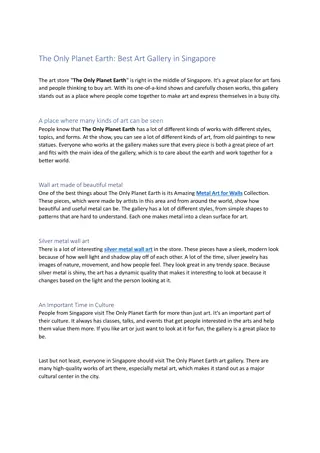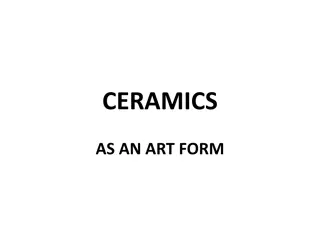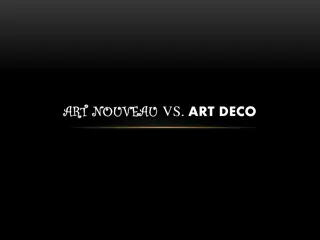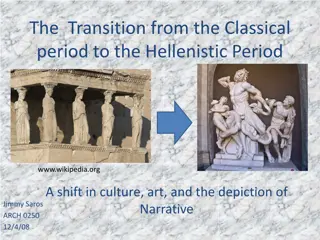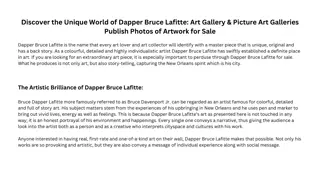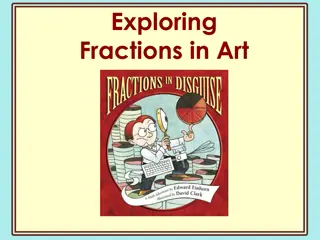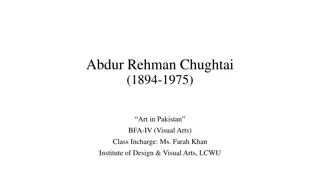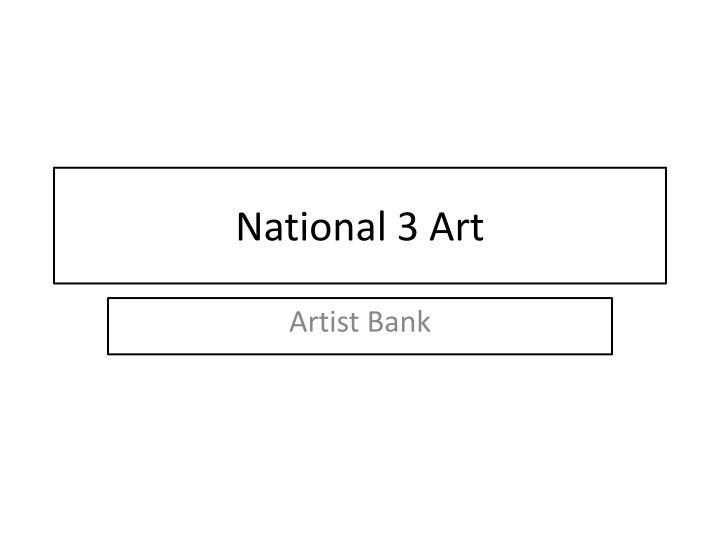
Robert Delaunay: French Artist of Divisionism, Cubism, and Orphism
Explore the life and art of Robert Delaunay, a prominent French artist known for his innovative contributions to Divisionism, Cubism, and Orphism. Discover his unique style characterized by geometric facets, dynamic movement, and vibrant colors in urban settings like Paris. Delve into his influences, techniques, and iconic works such as "L'Homme la tulipe." Learn about Pointillism as a technique within the Post-Impressionist movement.
Download Presentation

Please find below an Image/Link to download the presentation.
The content on the website is provided AS IS for your information and personal use only. It may not be sold, licensed, or shared on other websites without obtaining consent from the author. If you encounter any issues during the download, it is possible that the publisher has removed the file from their server.
You are allowed to download the files provided on this website for personal or commercial use, subject to the condition that they are used lawfully. All files are the property of their respective owners.
The content on the website is provided AS IS for your information and personal use only. It may not be sold, licensed, or shared on other websites without obtaining consent from the author.
E N D
Presentation Transcript
National 3 Art Artist Bank
Robert Delaunay Born: Robert-Victor-Felix Delaunay 12 April 1885 Paris, France Died: 25 October 1941 (aged 56) Montpellier, France Nationality: French Movement: Divisionism, Cubism, Orphism and Abstract Art Robert Delaunay Influenced by Neo-Impressionism and the painting technique known as pointillism or divisionism, in his early works Delaunay created forms using squares of colour that resembled a mosaic. He often left small areas of canvas blank to create a sense of space and light; even at this stage of development his interest in brilliant colour was notable. As his style matured, Delaunay further developed his mosaic-like squares into more complex geometric facets in which both solid objects and their surrounding spaces were fragmented, much like Cubism. These canvases are known for their dynamic sense of movement and their celebration of urban life, particularly Paris with Delaunay's oft- repeated motif of the Eiffel Tower. Robert Delaunay, Portrait de Jean Metzinger, 1906, oil on canvas, 55 x 43 cm Robert Delaunay, 1906, Jean Metzinger, oil on paper, 54.9 x 43.2 cm
L'Homme la tulipe (Portrait de Jean Metzinger) (1906) Oil on canvas Artwork description & Analysis: This portrait is one of a series that Delaunay and Metzinger painted of each other during the summer of 1906, many of which have been lost. Delaunay's painting captures both the debonair air of Metzinger and their spirit of collaborative experimentation. This painting shows the influence of Neo-Impressionism and Divisionism on Delaunay's colour as well as the influence of artists such as Edgar Degas and douard Manet in its unusual perspective. Like Seurat, Delaunay placed complimentary and opposite colours adjacent to each other on the canvas rather than mixing paints on the canvas - creating the effect of a hue and the illusion of depth, while giving the works a sense of static classicism. Delaunay was not a slavish follower of Divisionism, however, since his brushstrokes are freer and less precise, and the colour is not dictated by nature but is non-naturalistic, indicating Fauvist influences.
POINTILLISM Pointillism is a technique of painting in which small, distinct dots of colour are applied in patterns to form an image Pointillism is often considered part of the Post-impressionist movement. primarily invented by painters George Seurat and Paul Signac. While Impressionists used small dabs of paint as part of their technique, Pointillism took this to the next level using only small dots of pure colour to compose an entire painting. When was the Pointillism movement? Pointillism reached its peak in the 1880s and 1890s after the Impressionist movement. Many of the concepts and ideas, however, continued to be used by artists in the future. What are the characteristics of Pointillism? Unlike some art movements, Pointillism has nothing to do with the subject matter of the painting. It is a specific way of applying the paint to the canvas. In Pointillism the painting is made up entirely of small dots of pure colour. See the examples. It was Seurat s The Circus Van Gough s Self portrait in felt hat
Roy Litchenstein ROY LICHTENSTEIN IS a leading American artist, who was born in 1923. He usually makes very large paintings. He uses comic book images a lot often with words to give the images more impact. Roy Lichtenstein belongs to a group of artists known as Pop artists. The name came from their main source of inspiration, which was popular images of the day for example, movie stars, cars, comics, book, advertising and mass- produced objects. Other Pop artists include Andy Warhol and Jasper John. Girl with Hair Ribbon, c.1965 I...I'm Sorry!, 1965-1966 Oil and Magna on canvas 60 48 in 152.4 121.9 cm
Roy Lichtenstein was one of the most influential and innovative artists of the second half of the twentieth century. He is pre- eminently identified with Pop Art, a movement he helped originate, and his first fully achieved paintings were based on imagery from comic strips and advertisements and rendered in a style mimicking the crude printing processes of newspaper reproduction. These paintings reinvigorated the American art scene and altered the history of modern art. Lichtenstein s success was matched by his focus and energy, and after his initial triumph in the early 1960s, he went on to create an oeuvre of more than 5,000 paintings, prints, drawings, sculptures, murals and other objects celebrated for their wit and invention. Front cover Roy Lichtenstein Girls Catalogue 2008 Girl with Ball
We are now going to create our Portraits in the style of the Artist
Step 1 In order to draw a realistic-looking portrait, it is important to properly sketch the oval outline. You may have to try doing so a few times. If you want to draw a portrait as accurate as the one in my drawing, you must be patient and diligent. Step 2 Draw a horizontal line right in the middle of the oval to divide it into two parts, and a parallel line a little bit lower. From the middle of the lower line draw a vertical line and sketch the base of the nose. Step 3 You might find the process of drawing a human face fun and really absorbing, especially if you do the first steps correctly. Then you'll find it much easier to continue. Now, please sharpen your pencil until it is very fine. The eyes are typically the most important part of any portrait. Draw the Eyes, the pupils, the mouth line, and the hairline using curved oval lines.
Step 4 Although this stage might be a but challenging, once you complete it, your portrait is almost ready. I recommend drawing the easiest parts first. Draw the eyebrows and finish the hairline. Now, let's draw a more complex face element - the lips. Don't make the mouth too wide or the lips too thick. Start drawing the nose. Gently rub out extra pencil sketches with an eraser and evaluate your drawing so far. Step 5 If you've gotten to this stage quickly, you must be very artistic. Now you deserve some rest and won't have to draw any complicated parts in the portrait. All you have to do is to draw the eyebrows, the eyelids, and the ears in more detail. Step 6 Now you've got a real drawing of a face . The final step is to make a portrait out of it by giving it some volume, which is achieved by shading and contrasting. After you feel confident drawing a face step by step, try drawing a portrait off of a photograph.



